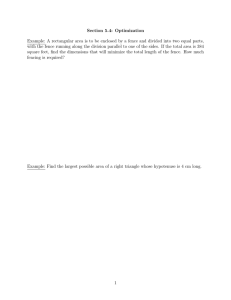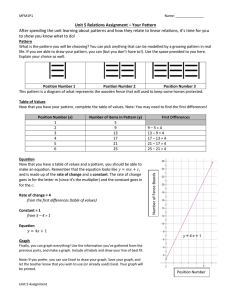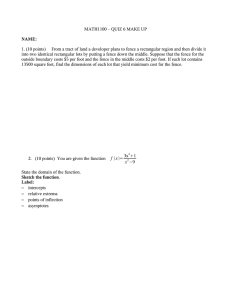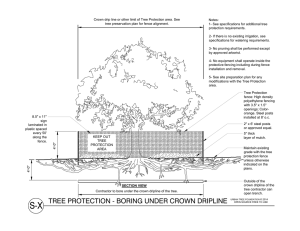UFGS 32 31 26 Wire Fences and Gates
advertisement
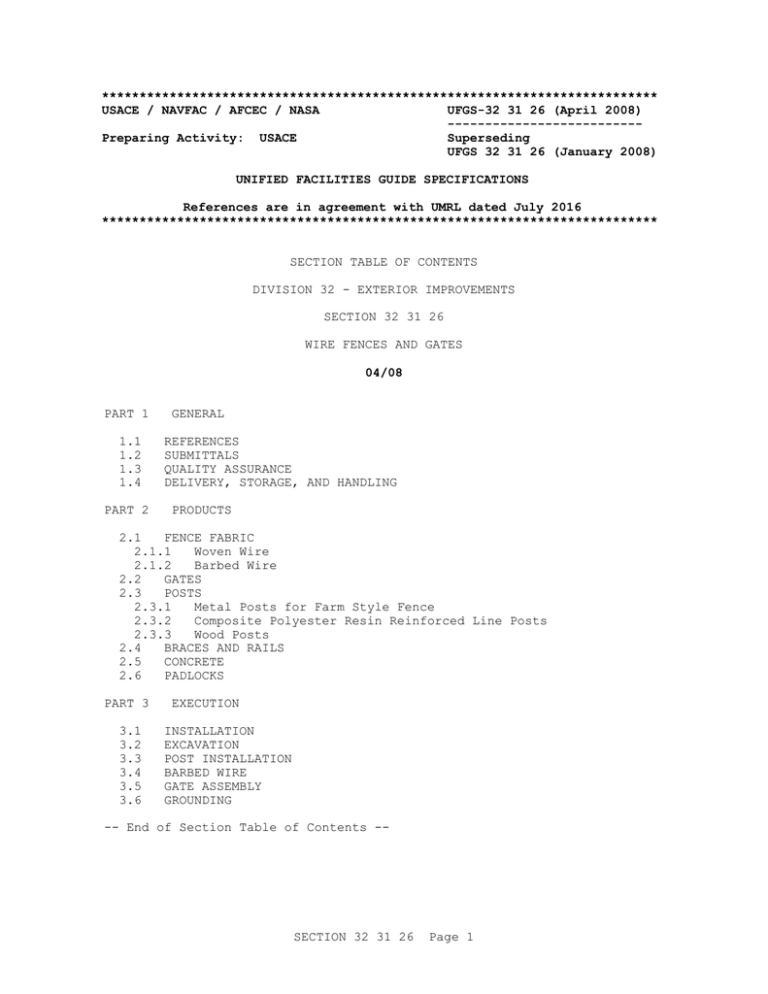
************************************************************************** USACE / NAVFAC / AFCEC / NASA UFGS-32 31 26 (April 2008) -------------------------Preparing Activity: USACE Superseding UFGS 32 31 26 (January 2008) UNIFIED FACILITIES GUIDE SPECIFICATIONS References are in agreement with UMRL dated July 2016 ************************************************************************** SECTION TABLE OF CONTENTS DIVISION 32 - EXTERIOR IMPROVEMENTS SECTION 32 31 26 WIRE FENCES AND GATES 04/08 PART 1 1.1 1.2 1.3 1.4 PART 2 GENERAL REFERENCES SUBMITTALS QUALITY ASSURANCE DELIVERY, STORAGE, AND HANDLING PRODUCTS 2.1 FENCE FABRIC 2.1.1 Woven Wire 2.1.2 Barbed Wire 2.2 GATES 2.3 POSTS 2.3.1 Metal Posts for Farm Style Fence 2.3.2 Composite Polyester Resin Reinforced Line Posts 2.3.3 Wood Posts 2.4 BRACES AND RAILS 2.5 CONCRETE 2.6 PADLOCKS PART 3 3.1 3.2 3.3 3.4 3.5 3.6 EXECUTION INSTALLATION EXCAVATION POST INSTALLATION BARBED WIRE GATE ASSEMBLY GROUNDING -- End of Section Table of Contents -- SECTION 32 31 26 Page 1 ************************************************************************** USACE / NAVFAC / AFCEC / NASA UFGS-32 31 26 (April 2008) -------------------------Preparing Activity: USACE Superseding UFGS 32 31 26 (January 2008) UNIFIED FACILITIES GUIDE SPECIFICATIONS References are in agreement with UMRL dated July 2016 ************************************************************************** SECTION 32 31 26 WIRE FENCES AND GATES 04/08 ************************************************************************** NOTE: This guide specification covers the requirements for Wire Fences and Gates. Adhere to UFC 1-300-02 Unified Facilities Guide Specifications (UFGS) Format Standard when editing this guide specification or preparing new project specification sections. Edit this guide specification for project specific requirements by adding, deleting, or revising text. For bracketed items, choose applicable items(s) or insert appropriate information. Remove information and requirements not required in respective project, whether or not brackets are present. Comments, suggestions and recommended changes for this guide specification are welcome and should be submitted as a Criteria Change Request (CCR). ************************************************************************** PART 1 GENERAL ************************************************************************** NOTE: This section covers non security applications for farm style fences. Edit this section throughout for the applicable project. Use Section 32 31 13 for CHAIN LINK FENCES AND GATES. Use Section 32 31 13.53 for HIGH-SECURITY CHAIN LINK FENCES AND GATES. Standard drawings STD 872-90-02 through 872-90-13 of fence and gate types required will be included as part of the contract drawings; the standard drawings are available at https://pdc.usace.army.mil/library/drawings/fence. Layout of fence will be shown including types and locations of gates, and gate sizes. Drawings will SECTION 32 31 26 Page 2 also indicate the extent of clearing required. ************************************************************************** 1.1 REFERENCES ************************************************************************** NOTE: This paragraph is used to list the publications cited in the text of the guide specification. The publications are referred to in the text by basic designation only and listed in this paragraph by organization, designation, date, and title. Use the Reference Wizard's Check Reference feature when you add a Reference Identifier (RID) outside of the Section's Reference Article to automatically place the reference in the Reference Article. Also use the Reference Wizard's Check Reference feature to update the issue dates. References not used in the text will automatically be deleted from this section of the project specification when you choose to reconcile references in the publish print process. ************************************************************************** The publications listed below form a part of this specification to the extent referenced. The publications are referred to within the text by the basic designation only. AMERICAN WOOD PROTECTION ASSOCIATION (AWPA) AWPA U1 (2015) Use Category System: User Specification for Treated Wood ASTM INTERNATIONAL (ASTM) ASTM A116 (2011) Standard Specification for Metallic-Coated, Steel Woven Wire Fence Fabric ASTM A121 (2013) Standard Specification for Metallic-Coated Carbon Steel Barbed Wire ASTM A153/A153M (2016) Standard Specification for Zinc Coating (Hot-Dip) on Iron and Steel Hardware ASTM A702 (2013) Standard Specification for Steel Fence Posts and Assemblies, Hot Wrought ASTM A780/A780M (2009; R 2015) Standard Practice for Repair of Damaged and Uncoated Areas of Hot-Dip Galvanized Coatings ASTM C94/C94M (2016) Standard Specification for Ready-Mixed Concrete ASTM D4541 (2009; E 2010) Pull-Off Strength of SECTION 32 31 26 Page 3 Coatings Using Portable Adhesion Testers ASTM F1043 (2016) Strength and Protective Coatings on Metal Industrial Chain-Link Fence Framework ASTM F1083 (2016) Standard Specification for Pipe, Steel, Hot-Dipped Zinc Coated (Galvanized) Welded, for Fence Structures ASTM F1184 (2016) Industrial and Commercial Horizontal Slide Gates ASTM F626 (2014) Standard Specification for Fence Fittings ASTM F883 (2013) Padlocks ASTM F900 (2011) Industrial and Commercial Swing Gates 1.2 SUBMITTALS ************************************************************************** NOTE: Review submittal description (SD) definitions in Section 01 33 00 SUBMITTAL PROCEDURES and edit the following list to reflect only the submittals required for the project. The Guide Specification technical editors have designated those items that require Government approval, due to their complexity or criticality, with a "G." Generally, other submittal items can be reviewed by the Contractor's Quality Control System. Only add a “G” to an item, if the submittal is sufficiently important or complex in context of the project. For submittals requiring Government approval on Army projects, a code of up to three characters within the submittal tags may be used following the "G" designation to indicate the approving authority. Codes for Army projects using the Resident Management System (RMS) are: "AE" for Architect-Engineer; "DO" for District Office (Engineering Division or other organization in the District Office); "AO" for Area Office; "RO" for Resident Office; and "PO" for Project Office. Codes following the "G" typically are not used for Navy, Air Force, and NASA projects. Use the "S" classification only in SD-11 Closeout Submittals. The "S" following a submittal item indicates that the submittal is required for the Sustainability Notebook to fulfill federally mandated sustainable requirements in accordance with Section 01 33 29 SUSTAINABILITY REPORTING. Choose the first bracketed item for Navy, Air Force and NASA projects, or choose the second bracketed SECTION 32 31 26 Page 4 item for Army projects. ************************************************************************** Government approval is required for submittals with a "G" designation; submittals not having a "G" designation are for [Contractor Quality Control approval.][information only. When used, a designation following the "G" designation identifies the office that will review the submittal for the Government.] Submittals with an "S" are for inclusion in the Sustainability Notebook, in conformance to Section 01 33 29 SUSTAINABILITY REPORTING. Submit the following in accordance with Section 01 33 00 SUBMITTAL PROCEDURES: SD-02 Shop Drawings Installation Drawings Fence Installation Location of Gate, Corner, End, and Pull Posts Gate Assembly Gate Hardware and Accessories SD-03 Product Data Manufacturer's Instructions Gate Assembly Gate Hardware and Accessories SD-04 Samples [ ] [ ][ ] [ ][ ] 1.3 Fence Fabric; G[, [_____]] Posts; G[, [_____]] Post Caps; G[, [_____]] Braces; G[, [_____]] Top Rail; G[, [_____]] Bottom Rail; G[, [_____]] Tension Wire; G[, [_____]] Barbed Wire; G[, [_____]] Stretcher Bars; G[, [_____]] Gate Posts; G[, [_____]] Gate Hardware and Accessories; G[, [_____]] Padlocks; G[, [_____]] QUALITY ASSURANCE Provide manufacturer's instructions that detail proper assembly and materials in the design for fence, gate assembly, gate hardware and accessories. Submit Installation drawings clearly indicating Fence Installation Location of gate, corner, end, and pull posts; Gate Assembly, Gate Hardware, catalog data and Accessories. 1.4 DELIVERY, STORAGE, AND HANDLING Deliver materials to site in an undamaged condition. Store materials off the ground to provide protection against oxidation caused by ground contact. Prior to shipment, submit the following samples for review and approval: [ Fence Fabric Posts Post Caps SECTION 32 31 26 Page 5 ] [ ][ ] [ ][ ] PART 2 2.1 Braces Top Rail Bottom Rail Tension Wire Barbed Wire Stretcher Bars Gate Posts Gate Hardware and Accessories Padlocks PRODUCTS FENCE FABRIC Provide fence fabric conforming to the following: 2.1.1 Woven Wire ASTM A116 [No. 9 farm] [No. 12-1/2 close mesh] [No. 14-1/2 wolf-proof] [No. 13 poultry and garden] [No. 14-1/2 chick] fence; grade, size as indicated.[ Applicable fittings shall conform to ASTM F626.] 2.1.2 Barbed Wire ASTM A121 [zinc-coated, Type Z, Class 3][aluminum-coated, Type A, with 12.5 gauge wire with 14 gauge, round, 4-point barbs spaced no more than 125 mm 5 inches apart.] 2.2 GATES ************************************************************************** NOTE: Show type of gates on the drawings, including degree of swing required. In heavy use conditions overhead slide gates should be considered if clearances permit, because these gates require less maintenance and repair than cantilever gates. Ground level track and roller systems should be avoided in climates where snow and ice may accumulate. Recessed tracks should never be used in climates where the recess may fill with ice and snow. Where gates are to receive electric locks, the gate post foundations should be lowered to frost depth to help prevent misalignment of the lock components. ************************************************************************** Provide gate type and swing shown conforming to ASTM F900 and/or ASTM F1184, ASTM A153/A153M. Gate frames shall conform to strength and coating requirements of ASTM F1083 for Group IA, steel pipe, with external coating Type A, nominal pipe size (NPS) 1-1/2. [Gate frames shall be polyvinyl chloride-coated steel pipe (Group IA)(Group IC) with external coating Type A, a nominal pipe size ()NPS) 1-1/2, conforming to ASTM F1043.] Gate leaves more than 2.44 m 8 feet wide shall have either intermediate members and diagonal truss rods or tubular members as necessary to provide rigid construction, free from sag or twist. Gate leaves less than 2.44 m 8 feet wide shall have truss rods or intermediate braces. Provide intermediate braces on all gate frames with an electro-mechanical lock. Attach gate fabric to the gate frame by method standard with the manufacturer. Welding is not permitted. Furnish latches, hinges, stops, keepers, rollers, and SECTION 32 31 26 Page 6 other hardware items as required for the operation of the gate. Arrange latches for padlocking so that the padlock will be accessible from both sides of the gate. Provide stops for holding the gates in the open position. 2.3 2.3.1 POSTS Metal Posts for Farm Style Fence Provide metal posts conforming to ASTM A702 zinc-coated, [T-section] [U-Section], length as indicated, and accessories conforming to ASTM A702. 2.3.2 Composite Polyester Resin Reinforced Line Posts ************************************************************************** NOTE: Composite posts may be used as an alternative to PVC coated steel line posts in salt- laden or corrosive industrial atmospheres. Since composite posts are non-conductive, fence grounding procedures need to be detailed where grounding of the fence is required. ************************************************************************** Provide polyester resin reinforced line posts produced from unsaturated polyester resin reinforced with E-glass. Fill posts with an appropriate filler material to form a rigid structural support member. The post shall meet the strength requirements of ASTM F1043 for heavy industrial fencing. Protect posts from UV and moisture degradation by a protective veil impregnated with resin (0.2 to 0.3 mm 8 to 12 mil minimum) and an acrylic based (0.05 mm 2 mil minimum) coating system. Posts shall exhibit corrosion and ultraviolet resistance as demonstrated when exposed to accelerated environmental test chamber for not less than 3,600 hours. The post shall not show structural failure (i.e., less than 10 percent loss of strength) as a result of exposure to moisture. Test post coating system strength in accordance with ASTM D4541 for 90 percent adhesion strength. Posts shall be [green] [black] [brown] in color. Provide outside diameter as specified in ASTM F1043 for round steel pipe. 2.3.3 Wood Posts Provide wood posts cut from sound and solid trees free from short or reverse bends in more than one plane. Make tops convex rounded or inclined. Provide posts free of ring shake, season cracks more than 6 mm 1/4 inch wide, splits in the end, and unsound knots. Provide posts of size and shape indicated. Treat posts in accordance with AWPA U1 as applicable. 2.4 BRACES AND RAILS ************************************************************************** NOTE: Normally, rails will not be specified except where appearance is important and the added cost is justified. When top rails are not specified, top tension wire will be used. Bottom tension wire will be specified unless a bottom rail is required for fence. ************************************************************************** ASTM F1083, zinc-coated, Group IA, steel pipe, size NPS 1-1/4. Group IC steel pipe, zinc-coated, meeting the strength and coating requirements of SECTION 32 31 26 Page 7 ASTM F1043. [Braces and rails shall be [Group IA] [Group IC], steel pipe, size NPS 1-1/4 or Group II,formed steel sections, size 42 mm 1-21/32 inch and be zinc coated (Type A) and polyvinyl chloride-coated conforming to the requirements of ASTM F1043.] Group II, formed steel sections, size 42 mm 1-21/32 inch, shall conform to ASTM F1043, if used as braces and rails when Group II line posts are furnished. 2.5 CONCRETE ASTM C94/C94M, using 19 mm 3/4 inch maximum size aggregate, and having minimum compressive strength of 21 MPa 3000 psi at 28 days. Provide grout consisting of one part portland cement to three parts clean, well-graded sand and the minimum amount of water to produce a workable mix. 2.6 PADLOCKS ************************************************************************** NOTE: Type P01 is key operated. Grade 6 is the top grade commercial lock; in Option A the key is captive in cylinder when padlock is unlocked; in Option B the cylinder is removable; Option 6 is environmentally resistant. For combination locks or other options and grades see ASTM F883. ************************************************************************** Provide padlocks conforming to ASTM F883, TYPE [EPB][_____], size [ 44 mm 1-3/4 inch][_____]. [All padlocks shall be keyed alike]. [All padlocks shall be keyed into master key system as specified in Section 08 71 00 DOOR HARDWARE]. PART 3 3.1 EXECUTION INSTALLATION ************************************************************************** NOTE: For farm style fence, the layout will be shown and will include fence section, height, mesh size, locations of straight-line and corner-post bracing, types and locations of gates, and gate sizes. Drawings will also indicate the extent of clearing required. Fences will not be located adjacent to natural or man-made terrain features that could provide easy access across the fence. The graded fence line will be indicated on the drawings where required. ************************************************************************** Install fence to the lines and grades indicated. Clear the area on either side of the fence line to the extent indicated. Space line posts equidistant at intervals not exceeding 3 m 10 feet. Set terminal (corner, gate, and pull) posts at abrupt changes in vertical and horizontal alignment. Provide continuous fabric between terminal posts; however, runs between terminal posts shall not exceed 152.4 m 500 feet. Any damage to galvanized surfaces, including welding, shall be repaired with paint containing zinc dust in accordance with ASTM A780/A780M. 3.2 EXCAVATION Clear loose material from all post holes. SECTION 32 31 26 Spread waste material where Page 8 directed. Eliminate ground surface irregularities along the fence line to the extent necessary to maintain a [25] [50] mm [1] [2] inch clearance between the bottom of the fabric and finish grade. 3.3 POST INSTALLATION For wood posts (Farm Style Fence), excavate to depth indicated and brace post until backfill is completed. Place backfill in layers of 229 mm 9 inches or less, moistened to optimum condition, and compacted with hand tampers or other approved method. Set posts plumb and in proper alignment. Drive metal posts or set in concrete as indicated. 3.4 BARBED WIRE Install wire on the side of the post indicated. Pull wire taut to provide a smooth uniform appearance, free from sag. Fasten wire to line posts at approximately 381 mm 15 inch intervals unless indicated otherwise. 3.5 GATE ASSEMBLY For farm style fencing, provide standard metal gate assemblies with frame and fittings necessary for complete installation or wood gates as shown. [3.6 GROUNDING ************************************************************************** NOTE: Delete this paragraph if grounding is not required. If grounding is required and lightning protection is not part of project design, the requirements in the second set of brackets will be used in lieu of those in the first set of brackets. Provide fence grounding details when composite type posts are specified where grounding of the fence is required. ************************************************************************** [Ground fences crossed by overhead powerlines in excess of 600 volts as specified in Section 26 41 00 LIGHTNING PROTECTION SYSTEM. Electrical equipment attached to the fence shall be grounded as specified in [Section 33 71 01 OVERHEAD TRANSMISSION AND DISTRIBUTION] [Section 33 71 02 UNDERGROUND ELECTRICAL DISTRIBUTION].] [Ground fences on each side of all gates, at each corner, at the closest approach to each building located within 15 m 50 feet of the fence, and where the fence alignment changes more than 15 degrees. Grounding locations shall not exceed 198 m 650 feet. Each gate panel shall be bonded with a flexible bond strap to its gate post. Ground fences crossed by powerlines of 600 volts or more at or near the point of crossing and at distances not exceeding 45 m 150 feet on each side of crossing. Ground conductor shall consist of No. 8 AWG solid copper wire. Grounding electrodes shall be 19 mm 3/4 inch by 3.05 m 10 foot long copper-clad steel rod. Drive electrodes into the earth so that the top of the electrode is at least 152 mm 6 inches below the grade. Where driving is impracticable, bury electrodes a minimum of 305 mm 12 inches deep and radially from the fence. The top of the electrode shall not be less than 610 mm 2 feet or more than 2.4 m 8 feet from the fence. Clamp ground conductor to the fence and electrodes with bronze grounding clamps to create electrical continuity between fence posts, fence fabric, and ground rods. After installation, the total resistance of fence to ground shall not be greater than 25 ohms.] SECTION 32 31 26 Page 9 ] -- End of Section -- SECTION 32 31 26 Page 10
